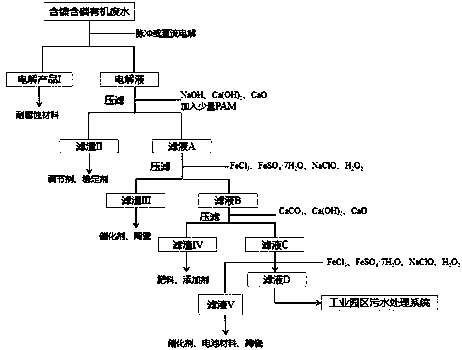Method for treating high-concentration nickel-phosphorus-containing organic waste liquid through electrolytic oxidation
A technology of electrolytic oxidation and organic waste liquid, applied in the direction of oxidized water/sewage treatment, chemical instruments and methods, filtration treatment, etc., can solve the problems of low COD removal rate, high cost, complex process, etc.
- Summary
- Abstract
- Description
- Claims
- Application Information
AI Technical Summary
Problems solved by technology
Method used
Image
Examples
Embodiment 1
[0020] (1) Accurately weigh 6 L of high-concentration nickel- and phosphorus-containing organic waste liquid with a metering device, apply a pulse electric field (pulse frequency 1000HZ, duty cycle 0.5), and a current density of 250 A / m 2 , after electrolysis for 24 h, electrolysis product Ⅰ (purity 86%) and electrolyte were obtained;
[0021] (2) Take 200 mL of the electrolyte solution obtained in step (1), add calcium oxide (15 g calcium oxide), adjust the pH to 14, stir and react for 4 h, and obtain leaching filter residue II and filtrate A after separation;
[0022] (3) Adjust the pH of the A filtrate obtained in step (2) to 4, add ferric chloride and ferrous sulfate heptahydrate (ferrous chloride 1.5 g, ferrous sulfate heptahydrate 1.5 g), and stir for 20 min;
[0023] (4) Add hydrogen peroxide and sodium hypochlorite (hydrogen peroxide 12 g, sodium hypochlorite 12 g) to the filtrate in step (3), add a small amount of PAM, stir and react for 4 hours, pour it into a solid-...
Embodiment 2
[0027] (1) Accurately weigh 6 L of high-concentration nickel- and phosphorus-containing organic waste liquid with a metering device, apply a pulse electric field (pulse frequency 1000HZ, duty cycle 0.5), and a current density of 300 A / m 2 , after electrolysis for 24 h, electrolysis product Ⅰ (purity 85%) and electrolyte were obtained;
[0028] (2) Take 200 mL of the electrolyte solution obtained in step (1), add calcium oxide (20 g calcium oxide), adjust the pH to 14, stir and react for 4 h, and obtain leaching filter residue II and filtrate A after separation;
[0029] (3) Adjust the pH of the A filtrate obtained in step (2) to 4, add ferric chloride and ferrous sulfate heptahydrate (2 g of ferrous chloride, 2 g of ferrous sulfate heptahydrate), and stir for 20 min;
[0030] (4) Add hydrogen peroxide and sodium hypochlorite (hydrogen peroxide 16 g, sodium hypochlorite 16 g) to the liquid in step (3), add a small amount of PAM, stir and react for 4 hours, pour into the solid-l...
Embodiment 3
[0034] (1) Accurately weigh 6 L of high-concentration nickel- and phosphorus-containing organic waste liquid with measuring equipment, apply a pulse electric field (pulse frequency 1000HZ, duty ratio 0.5), and a current density of 200 A / m 2 , after electrolysis for 24 h, electrolysis product Ⅰ (purity 84%) and electrolyte were obtained;
[0035] (2) Take 200 mL of the electrolyte solution obtained in step (1), add calcium oxide (30 g calcium oxide), adjust the pH to 14, stir and react for 4 hours, and obtain leaching filter residue II and solution A after separation;
[0036] (3) Adjust the pH of the A filtrate obtained in step (2) to 4, add ferric chloride and ferrous sulfate heptahydrate additives (1.5 g of ferrous chloride, 2 g of ferrous sulfate heptahydrate), and stir for 20 min;
[0037] (4) Add hydrogen peroxide and sodium hypochlorite (hydrogen peroxide 12 g, sodium hypochlorite 16 g) to the liquid in step (3), add a small amount of PAM, stir and react for 4 hours, the...
PUM
 Login to View More
Login to View More Abstract
Description
Claims
Application Information
 Login to View More
Login to View More - R&D
- Intellectual Property
- Life Sciences
- Materials
- Tech Scout
- Unparalleled Data Quality
- Higher Quality Content
- 60% Fewer Hallucinations
Browse by: Latest US Patents, China's latest patents, Technical Efficacy Thesaurus, Application Domain, Technology Topic, Popular Technical Reports.
© 2025 PatSnap. All rights reserved.Legal|Privacy policy|Modern Slavery Act Transparency Statement|Sitemap|About US| Contact US: help@patsnap.com

